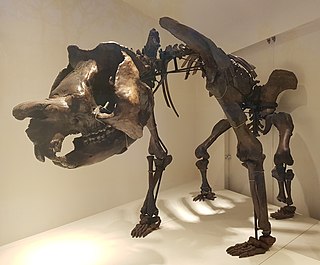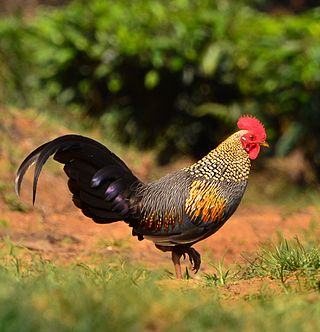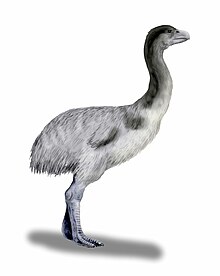
Diprotodon is an extinct genus of marsupial from the Pleistocene of Australia containing one species, D. optatum. The earliest finds date to 1.77 million to 780,000 years ago but most specimens are dated to after 110,000 years ago. Its remains were first unearthed in 1830 in Wellington Caves, New South Wales, and contemporaneous paleontologists guessed they belonged to rhinos, elephants, hippos or dugongs. Diprotodon was formally described by English naturalist Richard Owen in 1838, and was the first named Australian fossil mammal, and led Owen to become the foremost authority of his time on other marsupials and Australian megafauna, which were enigmatic to European science.

In zoology, megafauna are large animals. The precise definition of the term varies widely, though a common threshold used in paleontology is approximately 45 kilograms (99 lb), with other thresholds as low as 10 kilograms (22 lb) or as high as 1,000 kilograms (2,200 lb). Large body size is generally associated with other traits, such as having a slow rate of reproduction, and in large herbivores, reduced or negligible adult mortality from being killed by predators.

Rails are a large, cosmopolitan family of small- to medium-sized terrestrial and/or semi-amphibious birds. The family exhibits considerable diversity in its forms, and includes such ubiquitous species as the crakes, coots, and gallinule; other rail species are extremely rare or endangered. Many are associated with wetland habitats, some being semi-aquatic like waterfowl, but many more are wading birds or shorebirds. The ideal rail habitats are marsh areas, including rice paddies, and flooded fields or open forest. They are especially fond of dense vegetation for nesting. The rail family is found in every terrestrial habitat with the exception of dry desert, polar or freezing regions, and alpine areas. Members of Rallidae occur on every continent except Antarctica. Numerous unique island species are known.

Elephant birds are extinct flightless birds belonging to the order Aepyornithiformes that were native to the island of Madagascar. They are thought to have become extinct around 1000 AD, likely as a result of human activity. Elephant birds comprised three species, one in the genus Mullerornis, and two in Aepyornis.Aepyornis maximus is possibly the largest bird to have ever lived, with their eggs being the largest known for any amniote. Elephant birds are palaeognaths, and their closest living relatives are kiwi, suggesting that ratites did not diversify by vicariance during the breakup of Gondwana but instead convergently evolved flightlessness from ancestors that dispersed more recently by flying.

The New Zealand swan is an extinct indigenous swan from the Chatham Islands and the South Island of New Zealand. Discovered as archaeological remains in 1889, it was originally considered a separate species from the Australian black swan because of its slightly larger bones, and swans not having been introduced to New Zealand until 1864. From 1998 until 2017, it was considered to be simply a New Zealand population of Cygnus atratus, until DNA recovered from fossil bones determined that it was indeed a separate species, much larger and heavier than its Australian relative.

The term Australian megafauna refers to the megafauna in Australia during the Pleistocene Epoch. Most of these species became extinct during the latter half of the Pleistocene, and the roles of human and climatic factors in their extinction are contested.

Dromornithidae, known as mihirungs and informally as thunder birds or demon ducks, were a clade of large, flightless Australian birds of the Oligocene through Pleistocene epochs. All are now extinct. They were long classified in Struthioniformes, but are now usually classified as galloanseres. Dromornithids were part of the Australian megafauna. One species, Dromornis stirtoni, was 3 m tall. Only a single species, Genyornis newtoni survived into the Late Pleistocene. They are thought to have been herbivorous.

Dromornis is a genus of large to enormous prehistoric birds native to Australia during the Oligocene to Pliocene epochs. The species were flightless, possessing greatly reduced wing structures but with large legs, similar to the modern ostrich or emu. They were likely to have been predominantly, if not exclusively, herbivorous browsers. The male of the largest species, Dromornis stirtoni, is a contender for the tallest and heaviest bird, and possibly exhibited aggressive territorial behaviour. They belong to the family Dromornithidae, extinct flightless birds known as mihirungs.
Ilbandornis was a genus of ostrich-sized dromornithid. It was far more lightly built than other members of the family, indicating a more cursorial lifestyle. The majority of researchers consider Dromornithids to be herbivorous; this is borne out by molecular analysis of the gastroliths and eggshells of both Ilbandornis and the related Genyornis. While Ilbandornis and Genyornis have skulls of similar size to emus, other Dromornithids such as Bullockornis and Dromornis have far more robust skulls with large beaks; these were previously considered an adaptation for carnivory, but their blunt edges and lack of hooked tip indicate that the species were herbivorous. It is therefore likely that the differences in skull shape are due to differences in diet.
Barawertornis tedfordi was a dromornithid (mihirung), a large flightless fowl hailing from Late Oligocene to Early Miocene. The only species in the genus Barawertornis, its fossil remains are found in strata of the Riversleigh deposits located at two sites in Northwestern Queensland, Australia.

Lake Callabonna is a dry salt lake with little to no vegetation located in the Far North region of South Australia. The 160-square-kilometre (62 sq mi) lake is situated approximately 120 kilometres (75 mi) southwest of Cameron Corner, the junction of South Australia, Queensland and New South Wales. It is also known as Lake Mulligan.

Sthenurus is an extinct genus of kangaroos. With a length around 3 m (10 ft), some species were twice as large as modern extant species. Sthenurus was related to the better-known Procoptodon. The subfamily Sthenurinae is believed to have separated from its sister taxon, the Macropodinae, halfway through the Miocene, and then its population grew during the Pliocene.

Phascolonus is an extinct genus of giant wombat known from the Pliocene and Pleistocene of Australia. There is only a single known species, Phascolonus gigas, the largest wombat ever known to have existed, estimated to weigh as much as 200 kg or 360 kg (790 lb). It was described by Richard Owen in 1859. Phascolomys magnus is a probable junior synonym. P. gigas is distinguished from other wombats by its strap-shaped upper incisors. The cranial roof is noticeably inwardly depressed. The species was abundant across Australia, with remains having been found in all states except Western Australia. It is suggested to have had a preference for arid and semi-arid inland habitats, with a diet consisting of a high amount of low quality vegetation. Though it likely had wide home-ranges, it probably did not stray far from fresh water sources. Abundant remains have been found in Pleistocene aged deposits from Lake Callabonna in South Australia. Unlike its living relatives, it is unlikely that Phascolonus engaged in burrowing. Phascolonus disappeared during the Late Pleistocene Quaternary extinction event around 50-40,000 years ago, together with many other large Australian animals, following the arrival of humans to the Australian continent. Phylogenetic analysis suggests that is closely related to the other giant wombat genera Ramsayia and Sedophascolomys.

Gastornithiformes were an extinct order of giant flightless fowl with fossils found in North America, Eurasia, possibly Australia. Members of Gastornithidae were long considered to be a part of the order Gruiformes. However, the traditional concept of Gruiformes has since been shown to be polyphyletic.

Zygomaturus is an extinct genus of giant marsupial belonging to the family Diprotodontidae which inhabited Australia from the Late Miocene to Late Pleistocene.

Pangalliformes is the scientific name of a provisional clade of birds within the group Galloanserae. It is defined as all birds more closely related to chickens than to ducks, and includes all modern chickens, turkeys, pheasants, and megapodes, as well as extinct species that do not fall within the crown group Galliformes.

Progura is an extinct genus of megapode that was native to Australia. It was described from Plio-Pleistocene deposits at the Darling Downs and Chinchilla in southeastern Queensland by Charles De Vis.

The Odontoanserae is a proposed clade that includes the family Pelagornithidae and the clade Anserimorphae. The placement of the pseudo-toothed birds in the evolutionary tree of birds has been problematic, with some supporting the placement of them near the orders Procellariformes and Pelecaniformes based on features in the sternum.
Amandus Heinrich Christian Zietz was a zoologist and paleontologist born in Hamburg, Schleswig-Holstein, and best known for his work at the South Australian Museum in Adelaide, after arriving in South Australia in 1883.



























